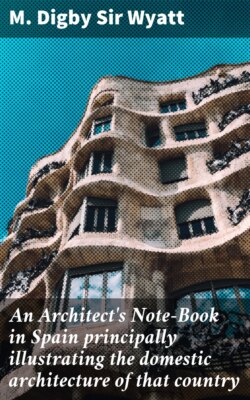Читать книгу An Architect's Note-Book in Spain principally illustrating the domestic architecture of that country - Sir M. Digby Wyatt - Страница 7
На сайте Литреса книга снята с продажи.
BURGOS. PATIO OF THE CASA DE MIRANDA.
ОглавлениеTHIS plate introduces us to the most striking feature of all important Spanish houses, the Patio, or internal courtyard, answering to and perpetuating the Atrium of Roman architecture, with its impluvium and compluvium, and corresponding with the ordinary Cortile of the Italians. It is usually rectangular in plan, and entirely surrounded upon at least two stories by arcading, behind which run passages into which open the doors of every principal set of apartments of the house. There are rarely many windows in the walls of the Patios, as the rooms generally occupy the whole width intervening between the Patio walls, and the external walls of the house from which the light is mainly derived. There are, however, usually more windows on the lower story of the Patio than on the upper, since the chief saloons requiring most light were on the first floor, while much of the lower floor was occupied as was also usual in Italy, by retainers, servants, poor guests, mendicant friars and administradores—to say nothing of mules, and horses with stores and munitions of all sorts.
Nothing can be more picturesque or better suited to the climate than these Patios, since owing to the deep arcades which surround the open part (the Cavædium) of the court-yard upon more stories than one, there is always some portion of the arcade in which shelter can be obtained from sun, rain, or wind, and in which the occupants of the several apartments can sit and work, or lounge and smoke, in abundant but not unbearable light, and perfect comfort. This facility of outlet enables them, during the hours when the sun shines most fiercely, to keep their living and sleeping rooms dark and cool, and in exactly the state to make the midday meal and subsequent siesta truly luxurious and refreshing.
One open staircase usually connects the upper and lower arcades; admission is rarely given to the whole building at more than one point, the great door, adjoining which is almost always to be found the concierge, the janitor of the old Roman house, upon the model of which the Spaniards probably founded their notion of a residence at once noble and comfortable.
Little need be said concerning the particular house sketched. It is one of the few left in Burgos to bear witness to the grandeur of its old aristocracy. Though once the residence of the powerful Condes de Miranda of the family of the Zunigas, it is now but a half ruined and entirely dirty lodging-house for the lower classes in a poor and neglected part of the city. A fine dedication to the most illustrious "Señor Don Francisco de çuñiga y Avellaneda, Conde de Miranda, Señor de la Villa Daça, y de la Casa de Avellaneda, by Pedro Martinez the Printer of Seville, in 1565," sets forth the arms as well as the style and title of the nobleman by whom, or by whose next descendant the "Casa de Miranda" of Burgos was probably built.
The present representative of this family is no other than the Conde de Montijo, head of the house to which Her Majesty the Empress of the French belongs. The remarkable "Casa solar" of Peñaranda de Duero, within an easy excursion from Burgos, once a magnificent villa of the Zunigas, was one of the hereditary possessions of her sister the Duchess of Alba.
There are some few other old houses remaining in Burgos, the most remarkable, for oddity rather than beauty, being the "Casa del Cordon;" so called from its façade, which exhibits a gigantic rope representing the "Cordon" of the Teutonic order, encircling and uniting, the arms of the Velascos, Mendozas, and Figueras with those of Royalty. It was erected by a Count Haro, Constable of Castile, at the end of the fifteenth century. It is now the residence of the Capitan General of the Province, and the property of the Duca de Frias, a descendant of Count Haro.
The Casa de Miranda is to be found in Burgos, in the "Calle de la Calera," not far from the "Barrio de la Vega." No English visitor to Burgos should omit to see the Convent of las Huelgas, most interesting not only as founded by an English Princess, (Leonora, daughter of Henry II, married to Alfonso VIII), in 1180; but as evidencing in its design, which is exceptionally grave, simple, and well proportioned, an unquestionably English architectural influence.
Of the Cathedral, remains of the Castle, and the Convent of the Cartuja it is needless to speak here, since they are certain not to be overlooked by the traveller. Mr. Waring, who has so well drawn the marvels of the last mentioned building,[3] has given some pretty illustrations of ornamental detail from the fine Renaissance "Ospedal del Rey," which may be found not far from the Convent of las Huelgas.[4]
